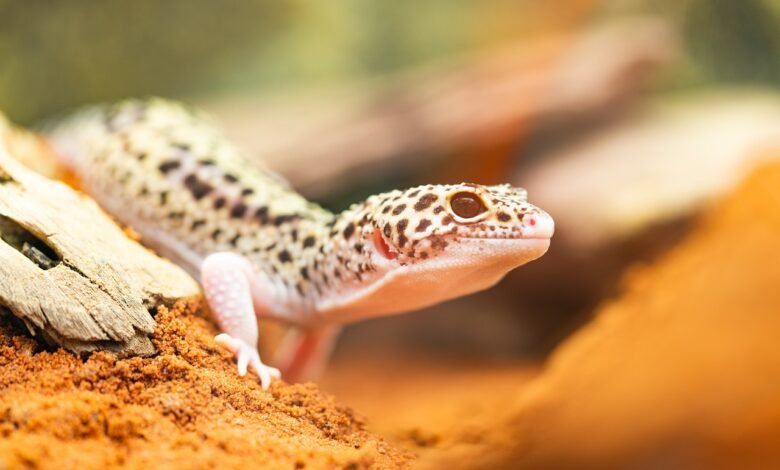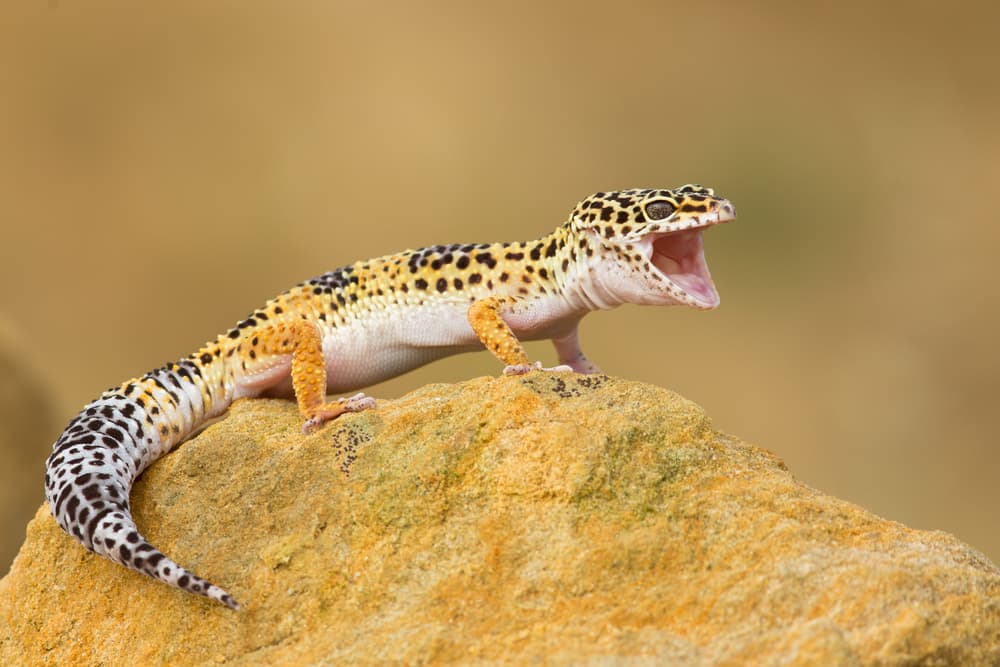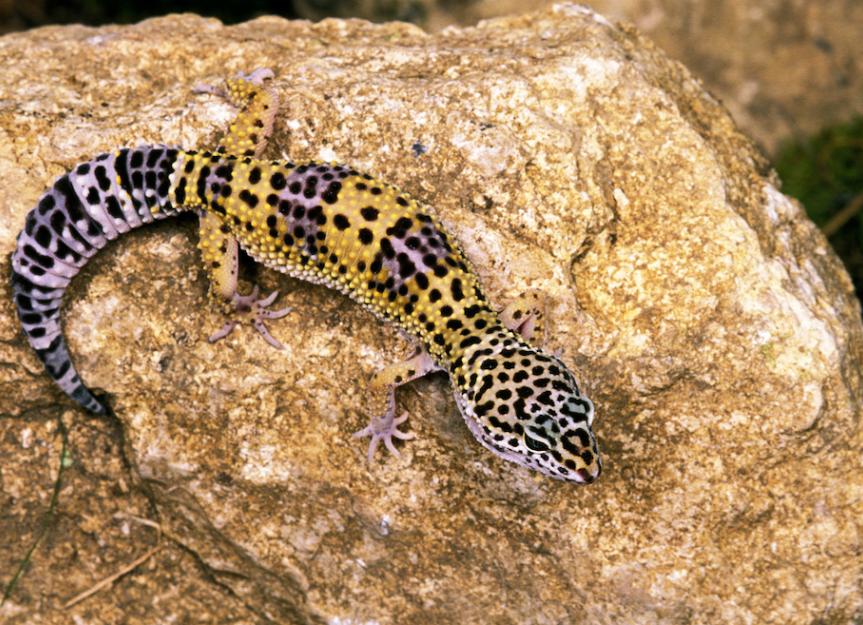How Long Do Leopard Geckos Live: Lifespan Secrets

Leopard geckos typically live for 15 to 20 years in captivity. Their lifespan can be influenced by various factors.
Leopard geckos are fascinating reptiles known for their distinctive appearance and docile nature. As popular pets, they are relatively low maintenance and can thrive in well-equipped terrariums. Understanding their lifespan is crucial for responsible pet ownership, ensuring proper care and attention throughout their lives.
By providing a suitable environment, nutrition, and regular veterinary check-ups, leopard gecko owners can help their beloved pets live long and healthy lives. Join us as we delve into the intriguing world of leopard geckos and uncover the secrets to their longevity.
Leopard Gecko Lifespan Basics
Leopard geckos have an average lifespan of 15 to 20 years when properly cared for. With good nutrition, a suitable habitat, and regular veterinary check-ups, these captivating reptiles can live a long and healthy life.
Leopard geckos are fascinating creatures and are popular as pets due to their docile nature and low-maintenance lifestyle. However, before deciding to bring one home, it’s essential to understand their lifespan basics. In this article, we’ll explore the typical lifespan of leopard geckos in the wild and captivity.
Typical Lifespan In The Wild
Leopard geckos are native to the deserts of Afghanistan, Pakistan, and India, where they live in the wild. In their natural habitat, they face several threats, including predators, extreme temperatures, and limited food and water resources. Due to these factors, the average lifespan of leopard geckos in the wild is around 6-10 years.
Expected Lifespan In Captivity
In captivity, leopard geckos can live much longer than their wild counterparts. With proper care and attention, they can live up to 20 years or more. Factors that can affect their lifespan in captivity include their diet, habitat, and overall health. Providing them with a well-balanced diet, a suitable environment, and regular check-ups by a veterinarian can help them live a long and healthy life.
| Factors Affecting Leopard Gecko Lifespan | How to Improve Leopard Gecko Lifespan |
|---|---|
| Unsuitable habitat | Provide a spacious and well-equipped terrarium |
| Unbalanced diet | Feed them a variety of insects and supplement their diet with calcium and vitamins |
| Poor hygiene | Clean their terrarium regularly and maintain proper hygiene |
| Stressful environment | Avoid loud noises, excessive handling, and other stressors |
In conclusion, understanding the lifespan of leopard geckos is crucial for providing them with the best possible care. By taking the necessary steps to ensure their well-being, we can help these fascinating creatures live a long and healthy life in captivity.
Genetics And Lifespan
Genetics play a significant role in determining the lifespan of leopard geckos. Understanding the inherited traits, genetic diversity, and vitality is crucial in comprehending the factors that contribute to their longevity. Let’s delve into these genetic aspects to gain insights into how they influence the lifespan of these fascinating reptiles.
Inherited Traits
Leopard geckos inherit various traits from their parents, including genetic predispositions that can affect their lifespan. These traits are passed down through generations, influencing their health and longevity.
Genetic Diversity And Vitality
The genetic diversity of leopard geckos is essential for their vitality and long-term health. A diverse genetic pool contributes to their ability to adapt to environmental changes and resist diseases, thereby enhancing their overall lifespan.
Habitat Influence On Longevity
Leopard geckos have varying lifespans depending on their habitat conditions. Factors such as temperature, humidity, and diet play a crucial role in their longevity. By providing optimal living conditions, leopard geckos can live for an average of 10 to 20 years in captivity.
Natural Habitats Vs. Captive Environments
Leopard geckos are fascinating creatures that can live for a significant period of time when provided with the right conditions. One of the key factors influencing their longevity is the habitat in which they are kept. Understanding the difference between natural habitats and captive environments is crucial in ensuring the health and longevity of these unique reptiles. In the wild, leopard geckos inhabit arid regions such as deserts and grasslands in countries like Pakistan, Afghanistan, and India. These areas provide a specific set of conditions that are difficult to replicate in captivity. Leopard geckos in their natural habitats have access to a variety of microhabitats, including rocky crevices, sandy areas, and vegetation. They also experience seasonal changes in temperature and lighting, which play a vital role in their overall well-being. When it comes to captive environments, it is essential to recreate the natural conditions as closely as possible. This includes providing a suitable terrarium that mimics the gecko’s natural habitat. By doing so, we can ensure they feel comfortable and thrive in captivity.
Creating An Optimal Terrarium
To provide an optimal terrarium for your leopard gecko, several factors need to be considered. These include temperature, humidity, lighting, substrate, and hiding places. Here are some key elements to focus on: 1. Temperature: Leopard geckos are ectothermic, meaning they rely on external heat sources to regulate their body temperature. Maintaining a temperature gradient within the terrarium is crucial. The warm side should be around 88-92°F (31-33°C), while the cool side should be around 75-80°F (24-27°C). This allows them to move between different temperature zones based on their needs. 2. Humidity: Leopard geckos thrive in low humidity environments. Aim for a humidity level of 30-40% to prevent respiratory issues and skin problems. Proper ventilation and the use of a hygrometer to monitor humidity levels are essential. 3. Lighting: While leopard geckos are primarily nocturnal, they still require a light source to maintain their circadian rhythm. Provide a low-wattage UVB light for 10-12 hours a day to simulate natural lighting conditions. 4. Substrate: Choose a safe and appropriate substrate for your gecko’s terrarium. Options include reptile carpet, paper towels, or non-adhesive shelf liners. Avoid loose substrates like sand or gravel, as they can pose a risk of impaction if ingested. 5. Hiding Places: Leopard geckos are secretive by nature and require hiding places to feel secure. Provide multiple hiding spots using natural-looking caves or commercial hides. This allows them to retreat and feel safe whenever they need to. By recreating the natural habitat conditions within a captive environment, you can significantly enhance the longevity and overall well-being of your leopard gecko. Remember to regularly monitor and adjust the terrarium’s conditions to ensure they remain optimal for your pet’s needs.
Diet’s Role In Gecko Longevity
When it comes to the longevity of leopard geckos, their diet plays a crucial role. Providing the right nutrition is essential for ensuring their overall health and lifespan. Let’s explore the nutritional requirements and common dietary mistakes that can impact the longevity of these fascinating reptiles.
Nutritional Requirements
Leopard geckos require a balanced diet that includes a variety of nutrients to support their growth and well-being. Their diet should primarily consist of insects such as crickets, mealworms, and dubia roaches. These insects serve as a source of essential protein, calcium, and vitamins that are vital for the gecko’s health.
Common Dietary Mistakes
One common mistake is feeding leopard geckos a diet that lacks variety. It’s important to offer a diverse range of insects to ensure they receive all the necessary nutrients. Additionally, some owners may overlook the importance of supplementing their gecko’s diet with calcium and vitamins. This can lead to nutritional deficiencies and impact the gecko’s longevity.
Healthcare For Leopard Geckos
Leopard geckos can live for 15 to 20 years with proper care. Providing a balanced diet, appropriate housing, and regular veterinary check-ups can contribute to their longevity. It’s essential to create a suitable environment with proper heating and lighting to ensure the well-being and long lifespan of your leopard gecko.
Routine Veterinary Care
Regular veterinary care is vital for maintaining the health and well-being of your leopard gecko. Just like any other pet, leopard geckos require routine check-ups to ensure they are in good health. During these visits, a veterinarian experienced in reptile care will conduct a thorough examination, checking for any signs of illness or potential health issues.
Common Health Issues And Prevention
While leopard geckos are generally hardy creatures, they can still encounter certain health issues. By understanding these common issues and taking preventive measures, you can help keep your gecko healthy and happy.
1. Impaction
Impaction occurs when a gecko ingests substrate material, such as sand or loose bedding, leading to blockages in their digestive system. To prevent impaction, it is crucial to use non-particulate substrates like reptile carpet or paper towels in your gecko’s enclosure.
2. Metabolic Bone Disease (MBD)
MBD is a common ailment in leopard geckos caused by calcium and vitamin D3 deficiencies. To prevent MBD, provide your gecko with a calcium supplement and ensure they have access to UVB lighting, which aids in vitamin D3 synthesis.
3. Respiratory Infections
Respiratory infections can occur if the temperature and humidity levels in the gecko’s habitat are not adequately maintained. Ensure the enclosure has a proper temperature gradient, ranging from 88°F (31°C) on the warm side to 75°F (24°C) on the cool side, and maintain humidity levels between 30-40%.
4. Parasites
Leopard geckos can be susceptible to internal and external parasites. Regularly check for signs of parasites, such as weight loss, decreased appetite, or abnormal fecal matter. If you suspect parasites, consult a veterinarian for proper diagnosis and treatment.
5. Shedding Difficulties
Leopard geckos shed their skin periodically, and difficulties during this process can lead to retained shed or incomplete shedding. Ensure proper humidity levels in the enclosure and provide a moist hide to facilitate shedding.
6. Tail Loss
Leopard geckos have the ability to drop their tails as a defense mechanism. While tail loss is a natural behavior, it’s important to prevent any injuries or infections that may occur as a result. Avoid handling your gecko by the tail, as it can cause stress and potential tail loss.
7. Eye Problems
Eye problems can occur in leopard geckos due to various factors, such as infections, injuries, or inadequate humidity levels. If you notice any discharge, swelling, or cloudiness in your gecko’s eyes, seek veterinary attention promptly.
By being aware of these common health issues and taking preventive measures, you can ensure your leopard gecko lives a long and healthy life. Remember to consult with a reptile veterinarian for specific care advice and any concerns you may have regarding your gecko’s health.
Stress Factors And Lifespan
Identifying Stress In Leopard Geckos
Leopard geckos are sensitive creatures, and stress can significantly impact their lifespan. Signs of stress in these reptiles include loss of appetite, hiding excessively, and tail dropping. If you notice any of these behaviors, it’s important to take immediate action to minimize stress and ensure your gecko’s well-being.
Minimizing Stressful Conditions
Creating a comfortable environment for leopard geckos is crucial for ensuring a long and healthy life. To minimize stress, maintain the appropriate temperature and humidity levels in their habitat. Additionally, provide hiding spots and reduce handling to prevent unnecessary stress. A well-balanced diet and regular veterinary check-ups are also essential for promoting a stress-free life for your leopard gecko.
Breeding And Its Impact On Life Expectancy
Understanding the impact of breeding on a leopard gecko’s life expectancy is crucial for responsible pet ownership. Let’s explore how the breeding cycle affects their longevity.
The Breeding Cycle
A female leopard gecko can lay multiple clutches of eggs throughout the breeding season.
Males may become stressed during mating, potentially impacting their health.
Proper care and monitoring are essential during the breeding process.
Longevity In Breeding Vs. Non-breeding Geckos
Breeding females may have a shorter lifespan due to the strain of producing eggs.
Males used for breeding may also experience a slight decrease in life expectancy.
Non-breeding geckos generally live longer and have fewer health complications.

Credit: www.jabberwockreptiles.com
Signs Of Aging In Leopard Geckos
Signs of Aging in Leopard Geckos:
Physical Changes
Leopard geckos may experience physical changes as they age.
Behavioral Shifts
Changes in behavior can indicate aging in leopard geckos.
Extending Your Gecko’s Life
Leopard geckos have a lifespan of 10 to 20 years, but with proper care, you can extend their life even further. By providing a suitable habitat, a balanced diet, regular vet check-ups, and a stress-free environment, you can ensure your gecko lives a long and healthy life.
Best Practices For Care
Innovations In Reptile Husbandry
Extending Your Gecko’s Life Leopard geckos can live up to 20 years with proper care. To extend your gecko’s life, follow these tips: – Provide a proper habitat with adequate space and hiding spots. – Maintain optimal temperature and humidity levels. – Offer a varied diet with gut-loaded insects. – Regularly clean the enclosure to prevent infections.
Best Practices For Care
Innovations In Reptile Husbandry
Innovations in reptile husbandry have led to advanced lighting and heating options. New enclosure designs prioritize naturalistic environments. Improved supplements cater to geckos’ specific nutritional needs.

Credit: dragonsdiet.com
Tales Of Longevity: Record-holding Leopard Geckos
Leopard geckos are known for their remarkable lifespan. Let’s delve into the fascinating world of these resilient creatures and uncover the secrets behind their impressive longevity.
Oldest Known Leopard Geckos
Meet the record-holding leopard geckos who defy the odds with their exceptional longevity:
- Maxine: Lived a remarkable 27 years.
- Rapunzel: Thrived for an impressive 28 years.
- Methuselah: Holds the title for living 32 years.
Secrets To Their Longevity
Unlock the mysteries behind the enduring lifespan of leopard geckos:
- Proper Nutrition: A balanced diet is key.
- Ideal Habitat: Provide a comfortable living environment.
- Regular Vet Check-ups: Ensure their well-being.
- Hydration: Keep them hydrated at all times.

Credit: www.petmd.com
Frequently Asked Questions
How Long Do Leopard Geckos Live In Captivity?
Leopard geckos can live up to 20 years in captivity with proper care and a suitable environment. Providing a balanced diet, maintaining ideal temperature and humidity levels, and regular veterinary check-ups can help ensure a long and healthy life for your leopard gecko.
What Factors Can Affect The Lifespan Of Leopard Geckos?
Several factors can influence the lifespan of leopard geckos. These include genetics, diet, habitat conditions, and overall care. Providing a clean and spacious enclosure, a varied and nutritious diet, and minimizing stress can all contribute to extending the lifespan of your leopard gecko.
How Often Should Leopard Geckos Be Fed?
Leopard geckos should be fed 2-3 times a week, with each feeding consisting of an appropriate portion size. Juveniles require more frequent feedings, while adults can be fed less often. It’s important to provide a balanced diet of live insects, such as crickets and mealworms, dusted with calcium and vitamin supplements.
Can Leopard Geckos Go Without Food For Long Periods?
Leopard geckos can go without food for several weeks, especially during periods of brumation or when they are not actively breeding. However, it is crucial to monitor their weight and overall health during this time. If a leopard gecko refuses to eat for an extended period, it may be a sign of an underlying health issue.
Conclusion
Leopard geckos are a popular pet choice for many reptile enthusiasts. Understanding their lifespan is crucial for providing them with the best care possible. With a lifespan of up to 20 years in captivity, leopard geckos can be a long-term commitment.
By providing a healthy diet, proper habitat, and regular veterinary checkups, owners can ensure their leopard geckos live long, happy lives. Remember to always do your research and consult with a veterinarian for any concerns.



